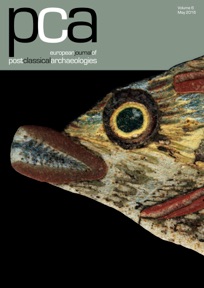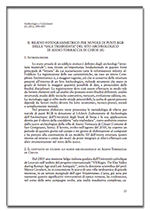 A. ARRIGHETTI, M. CAVALIERI. 2012. Il rilievo fotogrammetrico per nuvole di punti RGB della « sala triabsidata » del sito archeologico di Aiano-Torraccia di Chiusi (SI). Archeologia e calcolatori 23, p. 21-33 (in italiano).
A. ARRIGHETTI, M. CAVALIERI. 2012. Il rilievo fotogrammetrico per nuvole di punti RGB della « sala triabsidata » del sito archeologico di Aiano-Torraccia di Chiusi (SI). Archeologia e calcolatori 23, p. 21-33 (in italiano).
PDF : ART-AC-18-2012
Reconstructing the development of architectural complexes throughout time is often very diffcult. Buildings are usually a series of constructive actions, changes from the original project, and also collapses and reconstructions due to human actions (such as demolitions) and/or natural (earthquakes, foods, etc.). The building’s structure records all these events, giving us the chance to understand and decode them through the relief. The archaeological relief is thus supposed to offer a complete and rapid documentation. At the same time, it must be enriched with all the information needed for a deeper analysis of the archaeological object itself. In the last years, the introduction and continuous improvements of many instruments (e.g. laser scanners and photogrammetric technologies) have led to a sensible qualitative and quantitative change in the recording of the material structure.
In particular, the possibility to combine different relief technologies – obtaining high resolution, 3D geometrically correct models of buildings or of entire archaeological sites (which could be further investigated thanks to archaeological analysis or other procedures), has modified the archaeological approach towards the material “datum” and its divulgation. In order to achieve a better knowledge of nowadays technologies, the divulgation of different employed methodologies – through their application in research contexts – is the best way of transmission and comparison. This contribution is dedicated to the presentation and detailed analysis of a photogrammetric RGB point-clouds technology, used for the relief of a living-room during the archaeological excavation at Aiano-Torraccia di Chiusi (City of San Gimignano).

 M. Cavalieri, E. Boldrini, C. Bossu, P. De Idonè & A. Fumo, Aspetti della cultura materiale nelle fasi di riutilizzo (V–inizi VII sec. d.C.) della villa romana di Aiano-Torraccia di Chiusi (San Gimignano, Siena/Italy). Note preliminari dans REI CRETARIÆ ROMANÆ FAVTORVM ACTA 42, Bonn 2012, p. 169-180.
M. Cavalieri, E. Boldrini, C. Bossu, P. De Idonè & A. Fumo, Aspetti della cultura materiale nelle fasi di riutilizzo (V–inizi VII sec. d.C.) della villa romana di Aiano-Torraccia di Chiusi (San Gimignano, Siena/Italy). Note preliminari dans REI CRETARIÆ ROMANÆ FAVTORVM ACTA 42, Bonn 2012, p. 169-180. M. Cavalieri, A. Fumo, C. Bossu, 2012. Studio archeometrico delle ceramiche dalla villa romana di Aiano-Torraccia di Chiusi: risultati preliminari. FOLD&R 257. [en italien]
M. Cavalieri, A. Fumo, C. Bossu, 2012. Studio archeometrico delle ceramiche dalla villa romana di Aiano-Torraccia di Chiusi: risultati preliminari. FOLD&R 257. [en italien] M. Cavalieri, Destruction, transformation et refonctionnalisation. Le passage de l’Antiquité au Moyen-âge en Toscane entre les IVe et VIIe s. p.C.n. dans J. Driessen (ed.), Destruction. Archaeological, philological and historical perspectives, Louvain, 2013.
M. Cavalieri, Destruction, transformation et refonctionnalisation. Le passage de l’Antiquité au Moyen-âge en Toscane entre les IVe et VIIe s. p.C.n. dans J. Driessen (ed.), Destruction. Archaeological, philological and historical perspectives, Louvain, 2013.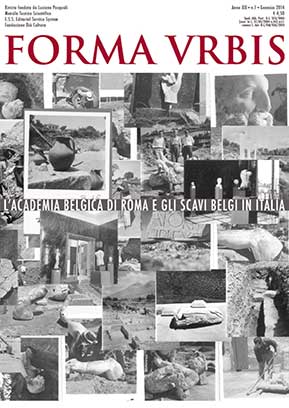 Dans le numéro de janvier de la revue italienne « Forma Urbis », consacré à l’Academia Belgica et aux fouilles belges en Italie, vous trouverez un article sur les fouilles à Aiano-Torraccia di Chiusi, ainsi que celles de
Dans le numéro de janvier de la revue italienne « Forma Urbis », consacré à l’Academia Belgica et aux fouilles belges en Italie, vous trouverez un article sur les fouilles à Aiano-Torraccia di Chiusi, ainsi que celles de 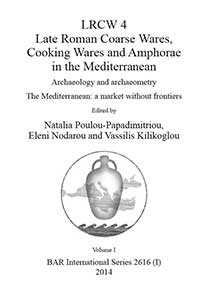 THE AMPHORAE IN THE ROMAN VILLA AT AIANO-TORRACCIA CHIUSI (SAN GIMIGNANO, SIENA-ITALY)
THE AMPHORAE IN THE ROMAN VILLA AT AIANO-TORRACCIA CHIUSI (SAN GIMIGNANO, SIENA-ITALY) E. Boldrini, M. Cavalieri, P. De Idonè, B. Magni, G. Pace
E. Boldrini, M. Cavalieri, P. De Idonè, B. Magni, G. Pace C. Bossu, L. Meulemans
C. Bossu, L. Meulemans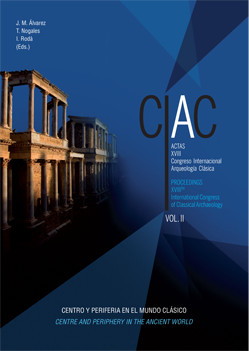 Late-antique Roman Villas in Central Italy. Compared Settlement Patterns: the Aiano-Torraccia di Chiusi Case in Proceedings of the XVIII International Congress of Classical Archaeology, vol. II, Merida, 2014, p. 1903-1906.
Late-antique Roman Villas in Central Italy. Compared Settlement Patterns: the Aiano-Torraccia di Chiusi Case in Proceedings of the XVIII International Congress of Classical Archaeology, vol. II, Merida, 2014, p. 1903-1906.